海外传真 | 展览:Back-Bad-Bone,鹿特丹
导言
AIVA Gallery
目前就读于比利时安特卫普皇家艺术学院的AIVA海外特派员卢雨曦,为读者带来荷兰艺术家兼策展人 Karin van Paassen日前于鹿特丹Galerie Wind举办的个展《Back-Bad-Bone》。在艺术家所擅长的原始艺术与象征主义风格中,观众不难感受到被灌注于作品中的强烈精神性,并感知到艺术家在创作过程中所经历的精神压力与肉体痛苦。
雨曦的访谈对话里,我们不仅看到艺术家的自我剖析,也看到了小记者的摸索与成长——感谢雨曦为AIVA当代首饰公众号的读者带来了如此真诚温暖的访谈。
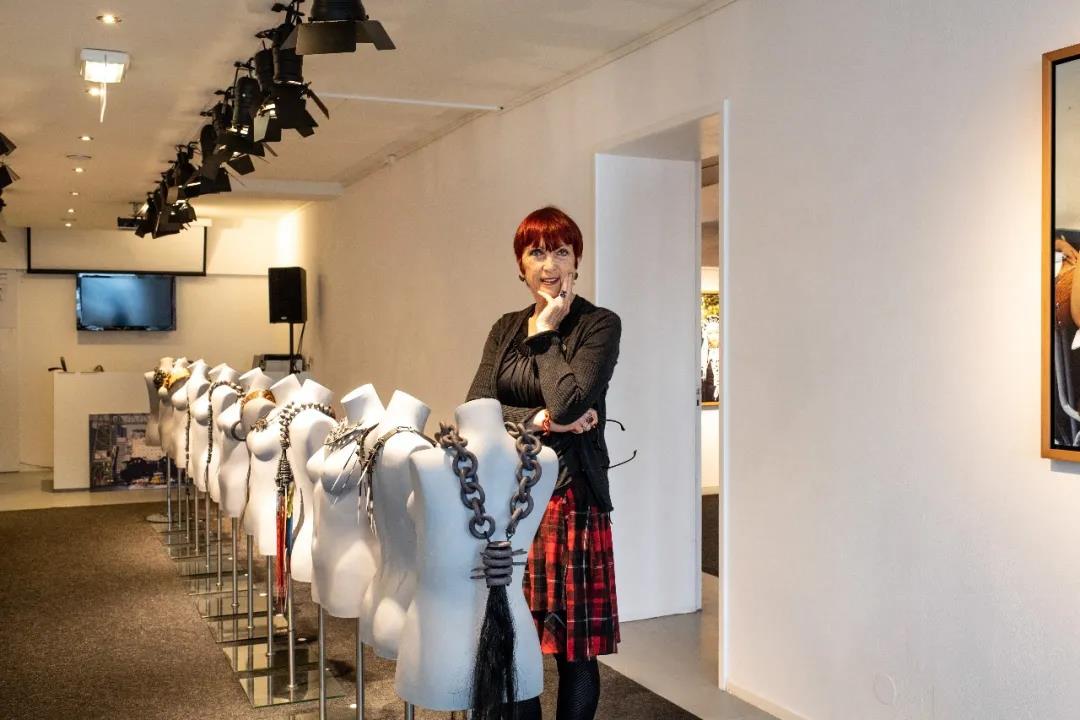
Karin van Paassen with her works
Photographer: Adriaan Backer
卡琳·范帕森和她的作品
摄影师:阿德里安·贝克尔
“I never make a drawing, I always follow my intuition during the making process.”
“创作过程中,我从不绘图。我总是跟随我的直觉。”
关于艺术家
About the Artist
卡琳·范帕森
(Karin van Paassen)
出生于1954年,荷兰
作为策展人,
Karin 30 多年来在国内外发起和组织了
多个文化和教育项目,
她的展览和教育项目主要涉及
设计、时尚、气味、纺织品、摄影
和建筑等领域,
尤其偏爱现代珠宝和民族珠宝。
16 年来,
Karin为 WEB.Foundation 开发项目,
特别关注亚洲和非洲的艾滋病毒/艾滋病。
她还积极担任多个组织的董事会成员,
并举办讲座和研讨会。
贯穿她职业生涯的主题是
连接机构和专业人士,
以及分享知识。
Karin曾经是一名精神科的护士,
1981年她开始学习丝网印刷,
在专供面料印刷的公司工作。
1982年至1986年,
她开始从事时尚设计与生产
以及室内产品的设计工作。
Karin对首饰有着毕生的热情。
她是一名狂热的民族首饰收藏家,
在各国旅游时经常会收藏
富有当地民族特色的首饰。
她常常被首饰在不同文化中的重要性,
其非常规的材料,
奢侈华丽的装饰,
权力的象征而着迷。

Photo by Yuxi Lu
Karin van Paassen
Born in 1954, the Netherlands.
Karin used to be a psychiatric nurse. She started training in silk screening in 1981, working in a company that focused on textile screen printing.
And she started on design and production of fashion and interior products during the year of 1982 – 1986.
She has had a lifelong passion for jewellery.
She is an avid collector of ethnic jewellery,
most of which she discovered during her extensive travels.
She is fascinated by the significance of jewellery in different cultures, the surprising use of unconventional materials, the lavishly opulent decorations and the power which is often attributed to jewellery.
As a curator Karin has initiated and organized cultural and educational projects, both nationally and internationally, for over 30 years.
She developed exhibitions and educational projects about -among other things - design, fashion, smells, textiles, photography and architecture, with special preference for modern jewellery and jewellery of ethnic origin.
For 16 years she has developed projects for WEB foundation, with a special focus on HIV/AIDS
in Asia and Africa.
She is also active as a board membe for a number of organizations, and she gives lectures and workshops.
The theme that runs through her career is connecting institutions and professionals, and sharing of knowledge.
Jewellery exhibitions and shows(part)
首饰展览(部分)
1997 Water, jewellery show in a watertower, Monster, the Hague
2006 Cross-over, jewellery exhibition at Galerie Lous Martin, Delft
2014 -2016 Gris Gris; jewellery workshops, show and tv programs, Rotterdam. In collaboration with Maastricht Academy of Fine Arts and Design & Boa Producties
2017 Gris Gris; jewellery exhibition in CODA Museum, Apeldoorn; jewellery&films
2019 Lectures about project Gris Gris in Shanghai and Jingdezhen (China)
2020 Concept & realization book ‘MyJewel’ with 100 stories about jewellery
2018 Jewellery project: Dutch Designers & Chinese Crafsmen, Shanghai, China
Exhibitions & educational projects for Historical Museum Rotterdam
鹿特丹历史博物馆的展览和教育项目
1988 - 2001 Kijkje achter de schermen
Dag rondom het hoofd
Show with fashion designers from Rotterdam
Dessins
Binnenkant Buiten
Kinderen in het Nieuw
Vervreemde Objecten
Variaties, part of Kleding op de Bon
Kleed – en versiergedrag in alle culturen
2002 100 jaar accessories, part of Uitgaan in Rotterdam
2002 - 2003 Ro-oots, designers from Rotterdam
2003 Ruik Rotterdam, 100 years smells in Rotterdam
2008 Bridges to Fashion; exchange between Turkish and Dutch designers with shows, a symposium, an exhibition. In collaboration with Trafik Foundation
关于展览
About the Exhibition
Introduction of exhibition--Back-Bad-Bone
(Text from Galerie Wind)
Back-Bad-Bone 展览介绍
(内容来自Galerie Wind)
大型的背部首饰是本次展览的主线。Karin 做了14件由黑色瓷珠,骨头和物件组成的大型背部首饰,与护身符,马毛和自然材料相结合。她在中国的陶瓷之乡景德镇制作瓷器串饰。中国的历史文化对Karin的作品有深厚的影响。许多中国元素被融入其中,如硬币、汉字和红色元素。
红色在中国象征着好运。
除了珠宝制作,卡琳还从事了30年的策展工作,在国内外组织了几十个展览和文化项目。
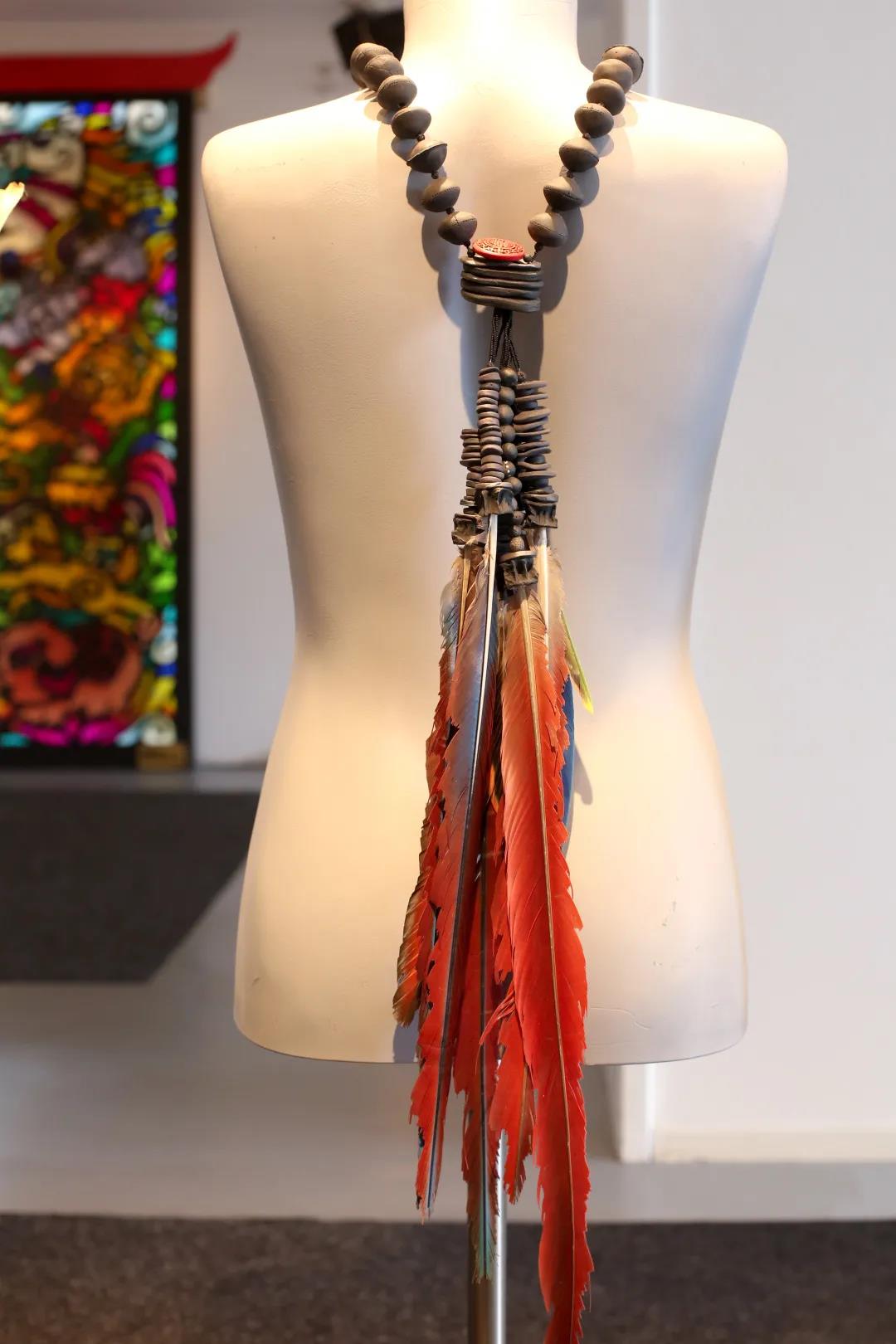
Photo by Yuxi Lu
The large back jewelry forms the backbone of the exhibition. Karin has made 14 large back jewelry with black porcelain beads, bones and objects, combined with charms, horsehair and natural materials. She makes the porcelain charms in the Chinese porcelain city Jingdezhen. The history and culture of China has a lot of influence on her work. Many Chinese elements have been incorporated, such as coins, characters and red accents.
Red is the color of luck in China.
In addition to making jewelry, Karin has been working as a curator for 30 years and has organized dozens of exhibitions and cultural projects at home country and abroad.
This interview is presented in the form of dialogue.
本次采访内容以对话的形式呈现。
Karin: I always make porcelain in black. Of course, I love white porcelain. It's beautiful. But I always wanted to make black porcelain jewellery. I've made something of white porcelain. But no, it must be black. So, I have never changed it. The jewellery is always black.
Karin: 我总是做黑色的瓷器。当然,我喜欢白瓷,它是美丽的。但我一直想做黑瓷首饰。我曾经做过一些白瓷的作品。但我觉得不行,它必须是黑色的。所以我从来没有改变颜色。我的珠宝总是黑色的。
Lu: May I know if the black color can show your feeling of back pain?
Lu: 黑色是否是为了体现你的背部的疼痛?
Karin: No, because before I had problems with my back, I always made it in black. So, it's a kind of a feeling. My own jewelry is also black. I love black. It has nothing to do with the meaning. It has always been like that. Also, when I was in Jingdezhen, still nothing white or other colors. It's just a feeling.
Karin: 不是的,因为在我的背部出现问题之前,我总是制作成黑色。所以这是一种感觉。我自己的首饰也是黑色的。我喜欢黑色,没有任何象征。一直都是这样。我在景德镇的时候也没有制作白色或其他颜色。黑色对我来说就是一种感觉。
Lu: So black is like your language, your symbolic color?
Lu: 所以黑色就像你的语言,具有代表性的颜色是吗?
Karin: Yeah. People would always say "Oh yeah this is Karin" when they see my work.
Karin: 是的。当人们看到我的作品时,他们总是会说: 啊是的!这是karin的作品。
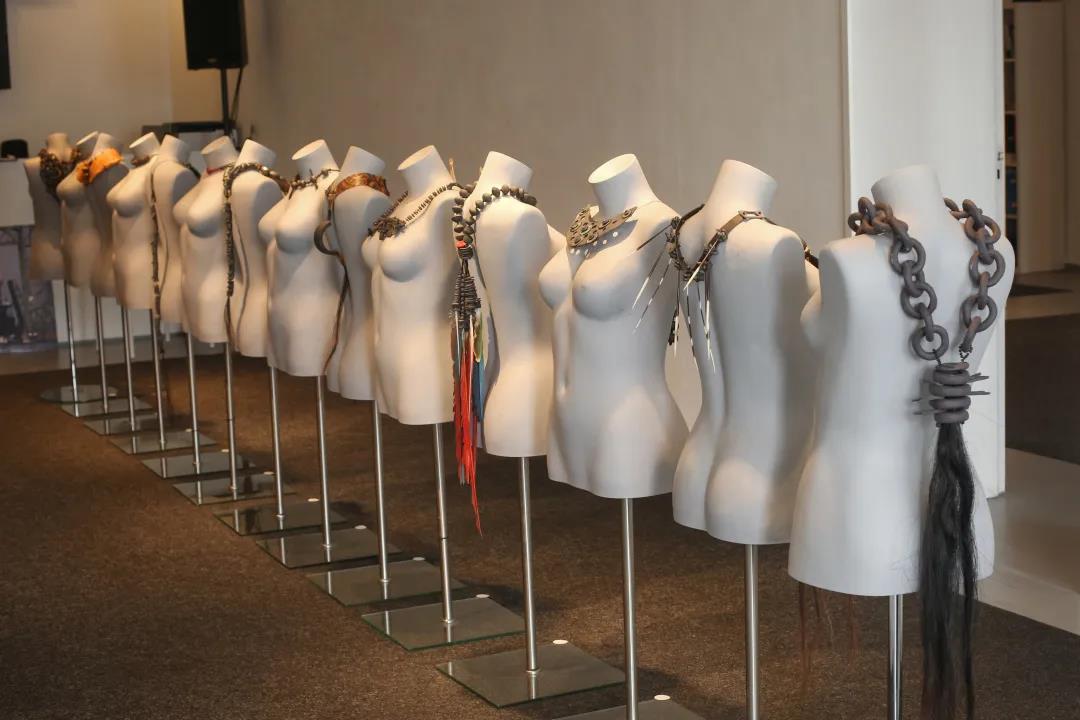
Image of the exhibition--Back-Bad-Bone
Back-Bad-Bone 展览图片
Photo by Yuxi Lu
Karin: Some things are always coming back, like horsehair and charms which are collected from all over the world. Let's say everything comes together in these jewellery. Let's have a walk.
Karin: 一些事物总是在不断重现,例如马毛和从世界各地收集的护身符。可以说,所有事物都汇聚在这些首饰上。我们走走吧。
Karin: It started here, because at that time I felt pain in my back. These are pins of a porcupine that I found on a street in Italy. I’ve kept them for years and years. When I started to make these works, I had a lot of pain. Because of that, I use these pins as all of them are very sharp.
Karin: 故事从这里开始,因为在那个时候我受到背部疼痛的困扰。这些是我在意大利的街上找到的豪猪脊椎。我保存了许多年。当我开始制作这些作品的时候,我感到许多疼痛。因此我使用了这些豪猪脊椎,因为他们都十分锋利。

Photo by Yuxi Lu
Lu: These pins really make me think about hurt and pain.
Lu: 这些尖刺真的让我联想到疼痛的感觉。
Karin: When I was with a woman who always did the massage, she had a long spine mold on her desk to explain everything about the back. I took one out and brought it to Jingdezhen, China. And asked them to make a mold of it. Then we could make hundreds of this shape. Combining with lava stone.
Karin: 当我在接受按摩治疗时,为我按摩的女士的桌子上有一个用来解释背部一切的脊椎模型。我从中取出了一颗并带到了中国景德镇。请当地人为它制作磨具,然后我们就可以制作上百个相同形状,并与火山石结合在一起。
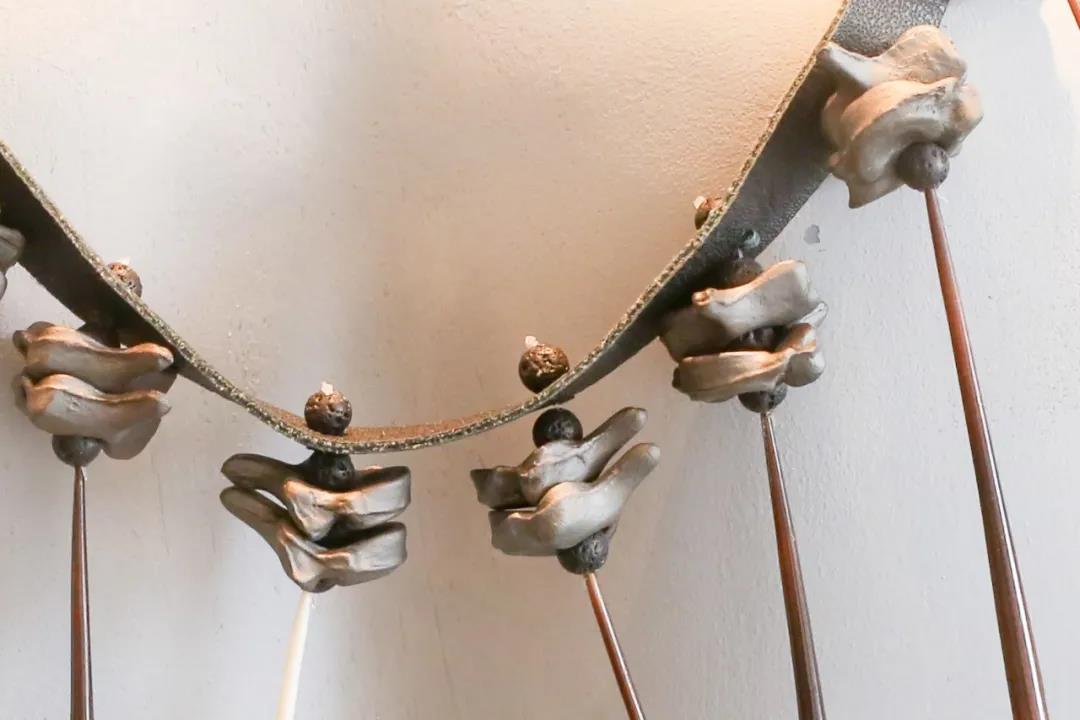
Detail
细节图
Photo by Yuxi Lu
Karin: The works are displayed in different kinds of ways on the mannequins, to be shown on the front and the back of the body. Let’s look around.
Karin: 这些作品以不同方式在人台的正面和背部交替展示。我们继续走走看吧。
Karin: You can see all these holes and coins. At that time, I was in China, I thought I had to show something of China. So, I used all these old coins that I found in a marketplace. Because I was recovering. I made holes to show that I felt a kind of relief.
Karin: 你可以看见这些孔洞和钱币。当时我在中国,我在想做些能够展现中国的事物。所以我用了所有我在中国市场上找到的钱币。当时我的背痛正在慢慢恢复,我做了这些孔洞表达一种舒缓的心情。

Photo by Yuxi Lu
Karin: For me it's not really a design development process. I was not just sitting at my desk to draw the design. And say “well, I'm going to make this”. No, it's just an organic way. It's a kind of a start of making.
Karin: 对于我来说,这完全不是所谓的设计过程。我不只是坐在桌子前绘制设计图,然后说“好,我将这样做。” 不是的,一切都是很自然的方式,是即刻开始制作。
Lu: In a natural way.
Lu: 十分自然的方式。
Karin: Yeah. I never make a drawing, I always follow my intuition during the making process.
Karin: 是的,创作过程中,我从不绘图,我总是跟随我的直觉。
Karin: This is the last Bad-Back-Bone. This is soft, all soft and colorful. I ended the making process with this one. It was a feeling that it had to be something soft. That's why I used all these feathers.
Karin: 这是Bad-Back-Bone的最后一件作品。是柔软的,彩色的。我以这件作品作为制作过程的结尾。我有一种感觉它得是柔软的事物。这也是我为什么使用这些羽毛的原因。

Photo by Yuxi Lu
Karin: All of these (clay plates) are made by hands. Those (clay spheres) are made with molds, because inside is hollow. You cannot make this by hand. I worked with an assistant who did all this work with the mold.
Karin: 这些(瓷片)全部是我手工制作的。那些(陶瓷球体)则是由磨具成型,因为它们内部是空心的,无法手工制作。我和一位助手一起工作,他用模具完成了这些所有工作。
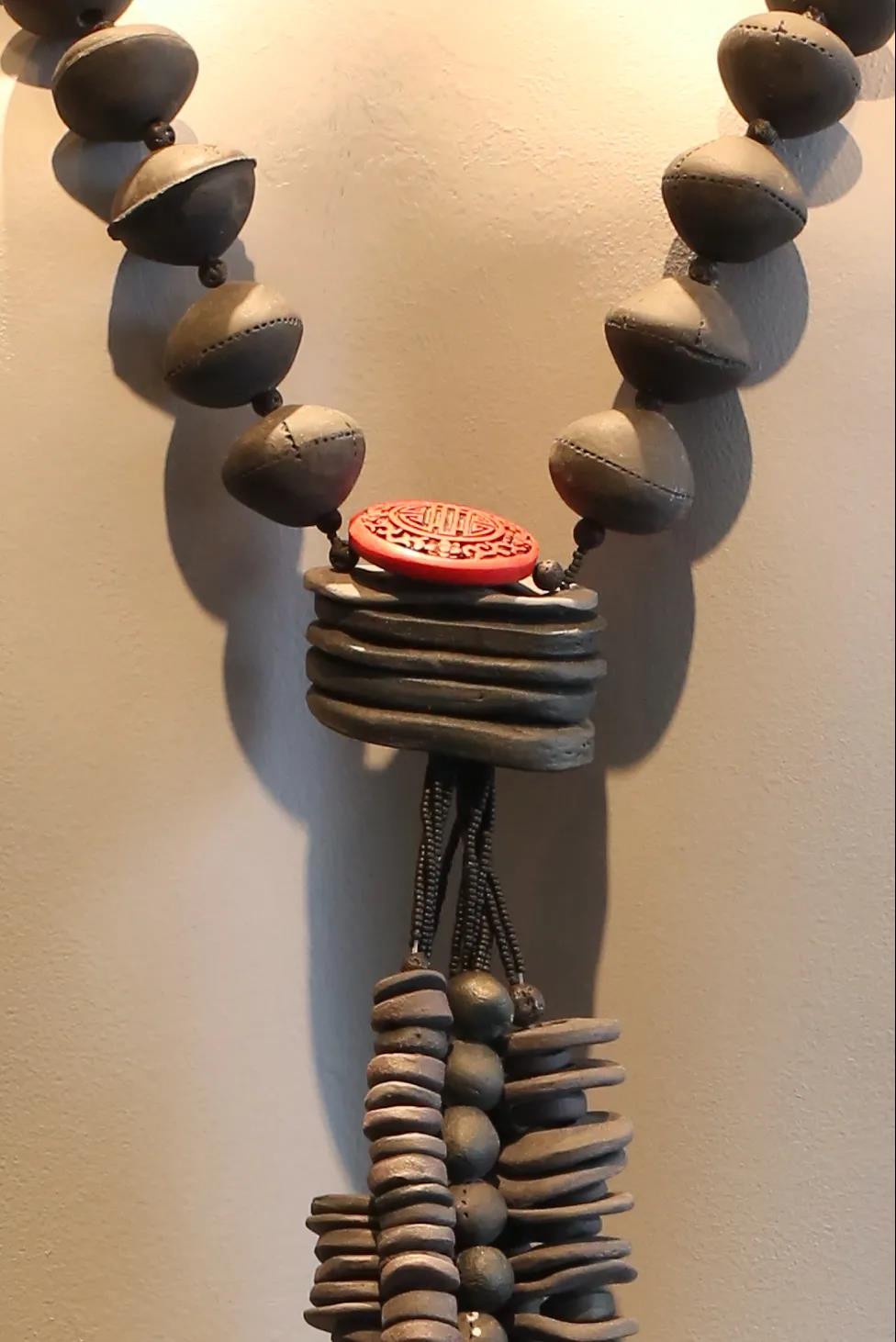
Photo by Yuxi Lu
Lu: Did you combine the two half-rounded parts together?
Lu: 你是将两半空心圆拼合在一起的吗?
Karin: Yes.
Karin: 是的。
Karin: In this piece, I want to show that for me the whole world is in this work. I have all kinds of beads and charms from all over the world. I pushed them in the clay, so the shapes you see are from all over the world, such as China and Africa. It's all printed in the clay and then I cut the shape out of it.
Karin: 这件作品,我想展示对于我来说整个世界都汇集在了这上面,我把我从世界各地搜集的珠子和护身符压进泥土里,所以你看见的这些形状是来自各个地方的,比如中国和非洲。它们都被压印在了泥土表面,随后我将它们的形状切割了出来。

Photo by Yuxi Lu
Lu: Did you put all the amulets together to gather good luck?
Lu: 你是将所有的护身符聚集在一起来召集好运吗?
Karin: Yes, it has something to do with this.
Karin: 是的,它确实与此有关
Karin: All of these things I also made by hand. Every piece took a lot of time. I have to try things that are not immediately done like this. Sometimes it takes two or three times to make. Sometimes I take it off and I think I have to change it. At first, I have an idea, and then I put it in my room for a week. And I think ‘no’, I take all out and make a new one. So, it sometimes takes two or three times to make something.
Karin: 这些物件也都是由我手工制作的。每一个都花了很长时间。我得尝试一些无法立马得到结果的事情。有时候会制作两到三次。甚至有时会把它们取下来换掉。通常在一开始我有一个想法,把它们放在房间一周后觉得“这样不行”,把他们全部取出再重新制作。所以有时候会花两到三次来制作一些作品。
Karin: I always have this leather which was from my brother who worked in Africa. The Toeareg (men of the desert) painted the leather and they use it on the horses.
Karin: 我一直有这种皮革,是从我曾在非洲工作的哥哥那里得到的。图阿雷格人(住在沙漠的人们)通常在皮革上绘制图案,用于装饰马匹。

Photo by Yuxi Lu
Lu: For sitting place?
Lu: 用于马鞍吗?
Karin: For sitting on it, for boots, for all kinds of things. I love it. It is also part of my life because I've been a lot of times to Africa.
Karin: 用于马鞍,靴子,各种事物。我很喜欢它。这也是我生命中的一部分,因为我曾经去过很多次非洲。
Lu: And you also connect with the horsehair in this piece.
Lu: 在这件作品中你也用了马毛进行结合。
Karin: You see, there is still the shape of the back. Sometimes my back felt like this. It felt like hurt and pain. And still, it is hollow. It's a combination of thinking about my back and feeling. I tried to find all kinds of forms to show how I felt.
Karin: 你看,这也是一个背部的形状。有时候我的背感觉就像这样被卷曲,十分疼痛。它也是空心的。这是我思考背部和自我感受的结合。我尝试寻找一切能够表达我感受的表现形式。
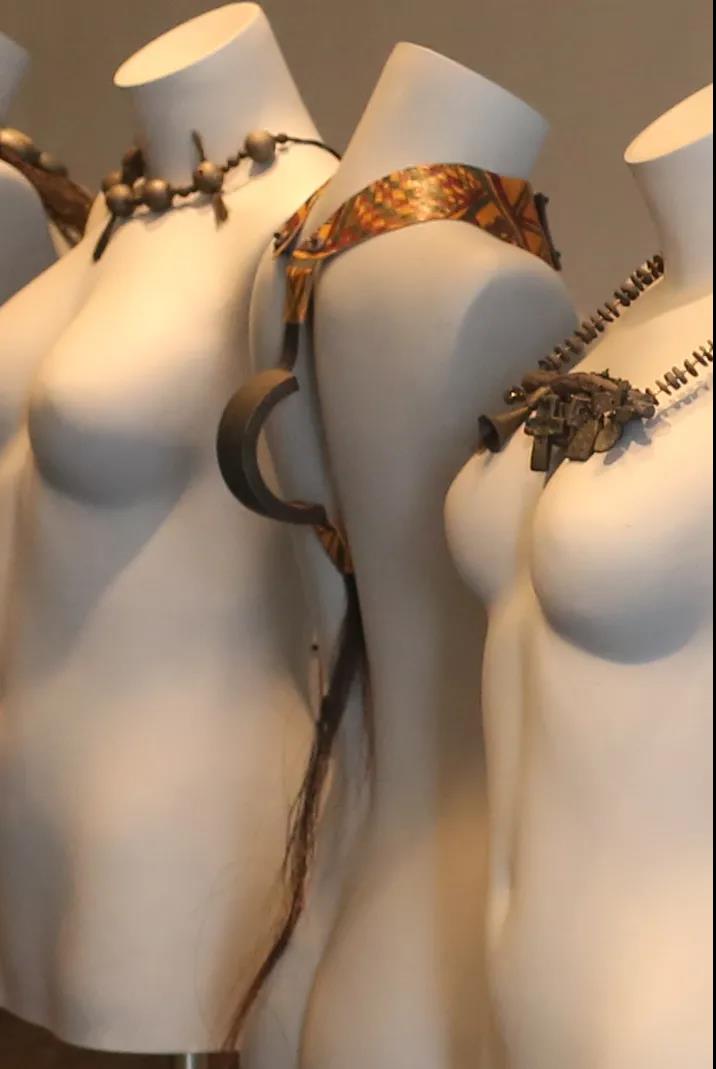
Photo by Yuxi Lu
Karin: These are also hollow beads I made. Every time when I have new beads, I can change all kinds of things before placing them in the kiln. Again, combining with the lava stone.
Karin: 这些也是我做的空心珠子。每次我有新的珠子,在把它们放入窑炉之前,我能任意改变它们的形态。再一次与火山石结合。
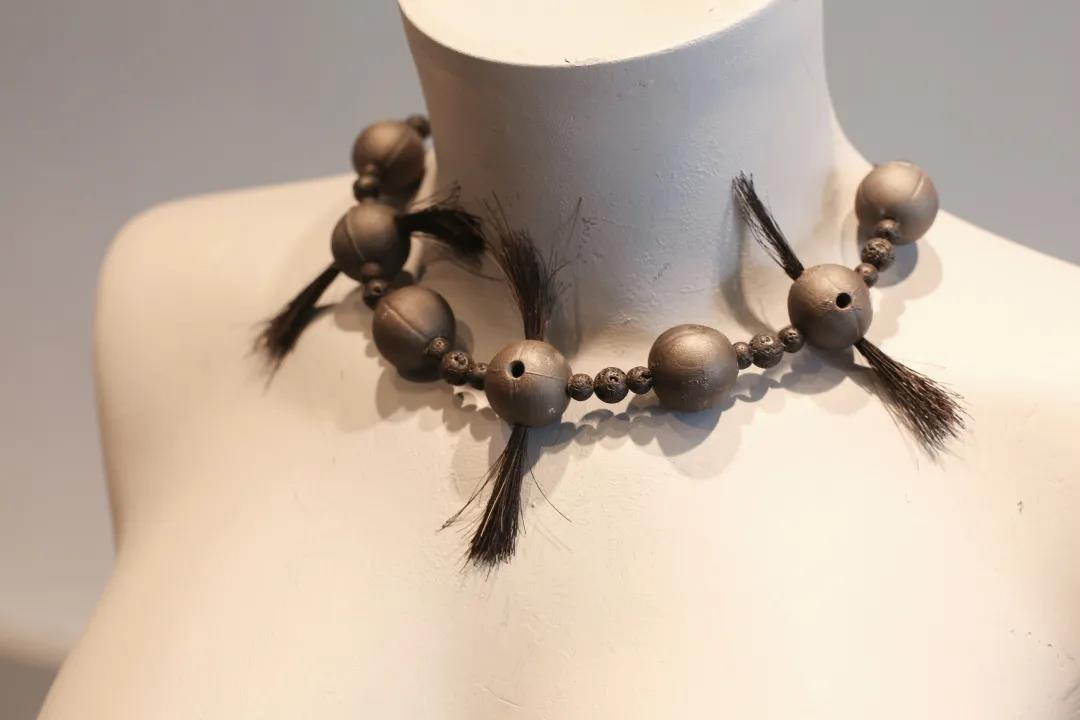
Photo by Yuxi Lu
Lu: I think the characteristics of the two materials (Porcelain and lava stone) seems quite similar yet different.
Lu: 我觉得瓷珠和火山石两种材料的质感既相似又不同。
Karin: I also made a lot of eggs.
Karin: 我也制作了许多蛋。
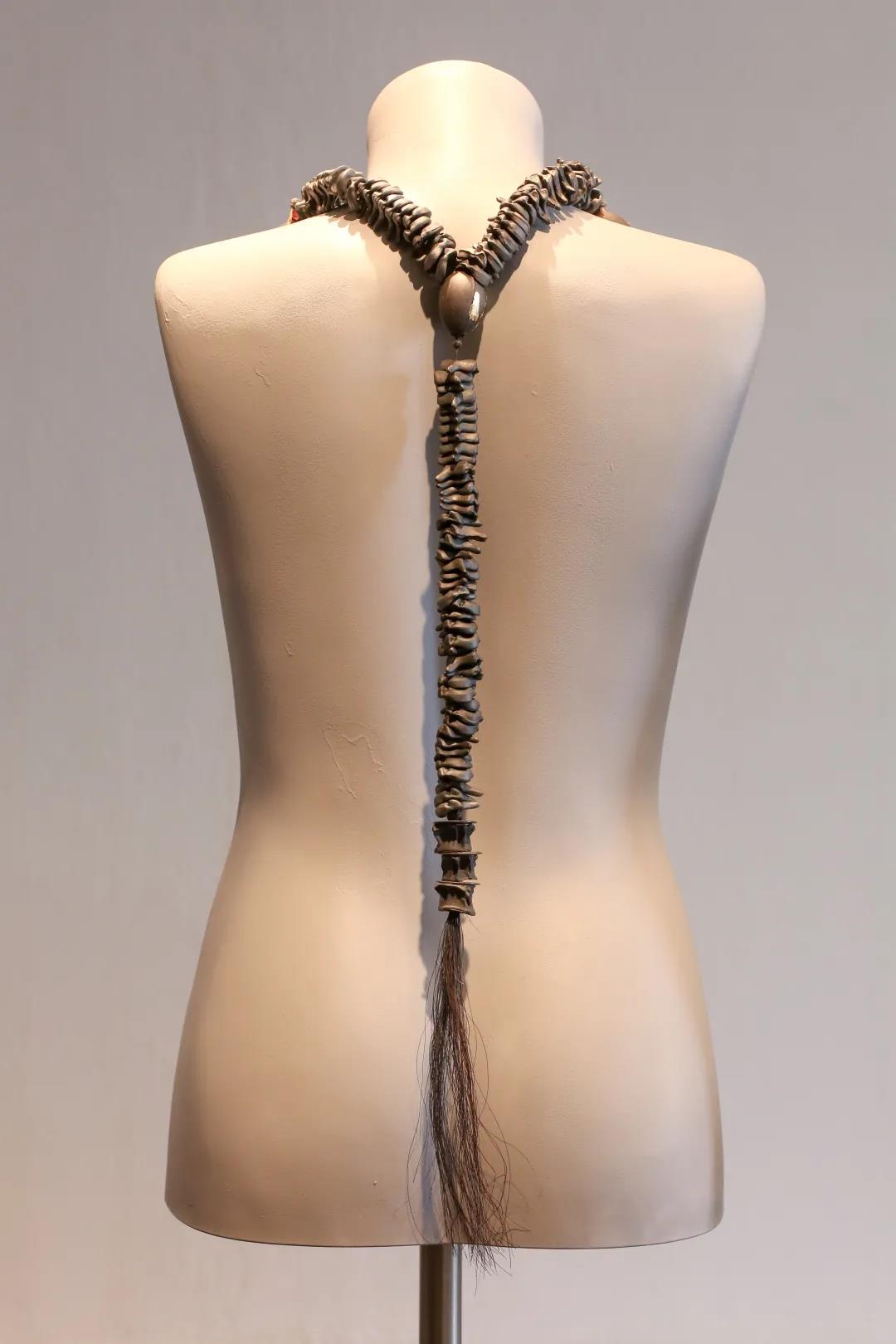
Photo by Yuxi Lu
Karin: It started with this one that I want to make black beads. It is a bone of a fish that I found on the beach where I live. And that was the moment that I thought I wanted to make black beads. I don't know why. It was a long time ago. And at that time, I didn't have these back problems. They made a mold out of fishbone. Then I could make a lot of pieces of this shape.
Karin: 这件作品是我想制作黑色瓷珠的开端。这是在我住的沙滩上发现的鱼骨。就在那个时刻,我开始想要制作黑色瓷珠。我不知道为什么。很久以前的事情了。那个时候我还没有背部疼痛的困扰。他们为这颗鱼骨制作了模具。随后我就可以翻制出更多相同的造型。
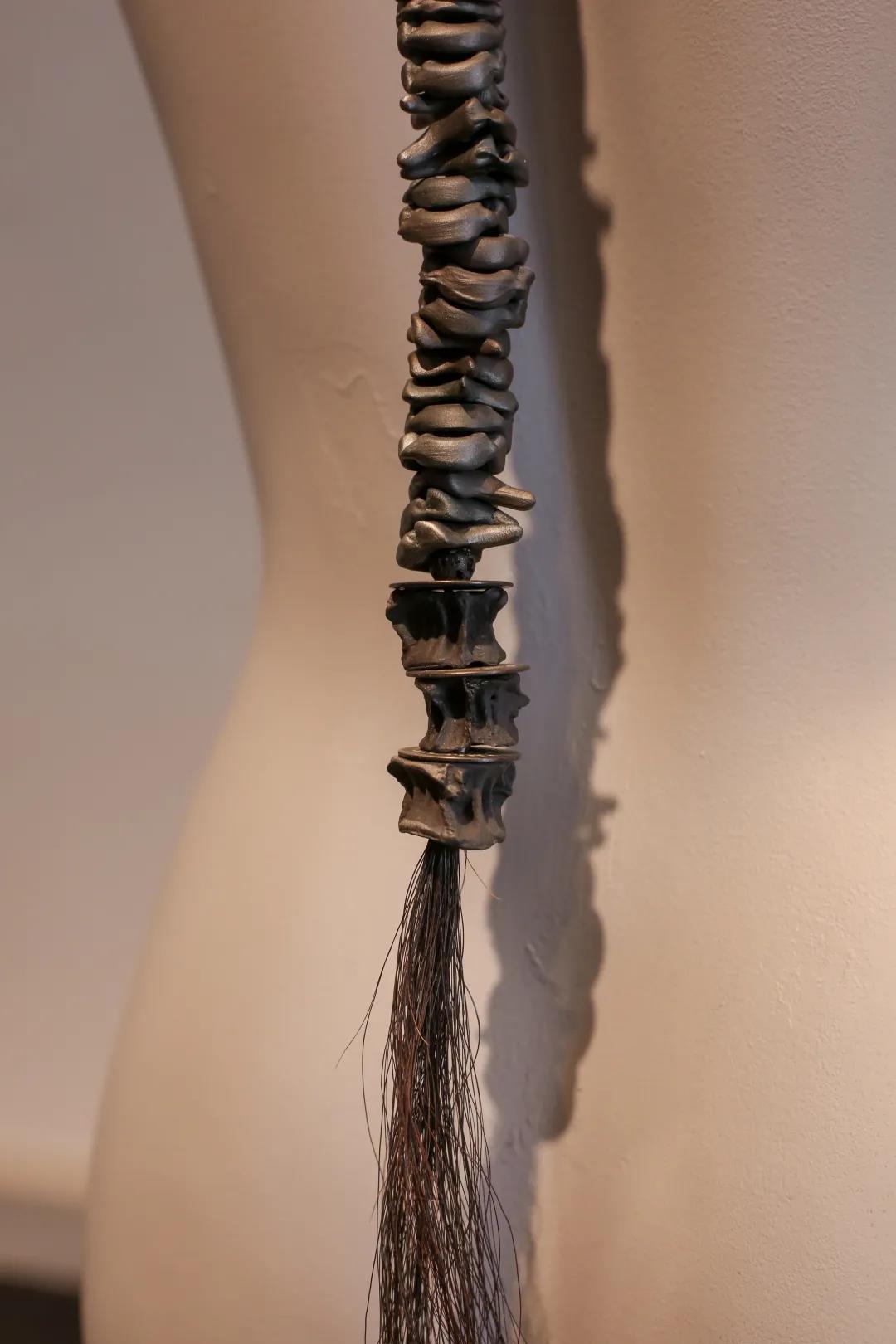
Photo by Yuxi Lu
Lu: Does the egg symbolize something?
Lu: 蛋是否象征着什么呢?
Karin: Yeah, it has something to do with fertility, and with new life. I recovered so that I have this kind of feeling.
Karin: 是的,与生殖力和新生有关。因为我痊愈了,所以我有那样的感受。
Karin: They are skulls, symbol of death. It's not a natural stone. It is a kind of plastic. But I had to put it in it. I had to show something like skulls. I don't know. It just happened.
Karin: 这些是骷髅头,死亡的象征。这不是天然石料,是一种塑料。但我得把它放进去。我得展现一些像骷髅一样的事物。我不知道,就这样发生了。


Backside of the work
作品背面
Lu: There's a Chinese word “福” in the middle of necklace that means happiness.
Lu: 我看见在项链中间有一个中文“福”字,意味着幸福。
Karin: Yes. It shows different feelings at the same time. That's how it worked. Because at that time I was sick. I didn't feel good. But at the same time, all my friends are so sweet to me. It's a combination of different feelings, mixed feeling.
Karin: 是的,它展现了同一时期的不同感受。这就是我这样做的原因。因为在那个时候我生病了,感觉很糟糕。但与此同时我的朋友都对我十分的关爱。这是不同感受的结合,可以说是百感交集。
Karin: Here is broken back that I connected them with the silver from Senegal, west of Africa. Then, again, the tail. I don’t know why. Every time I have to do with horse tail. I also wanted to make them sharp.
Karin: 这是由塞内加尔银连接起来的断掉的脊背,塞内加尔位于非洲西部。我再一次使用了马尾。不知道为什么,每一次我都会使用马尾。我也想把脊背做得很锋利。

Photo by Yuxi Lu
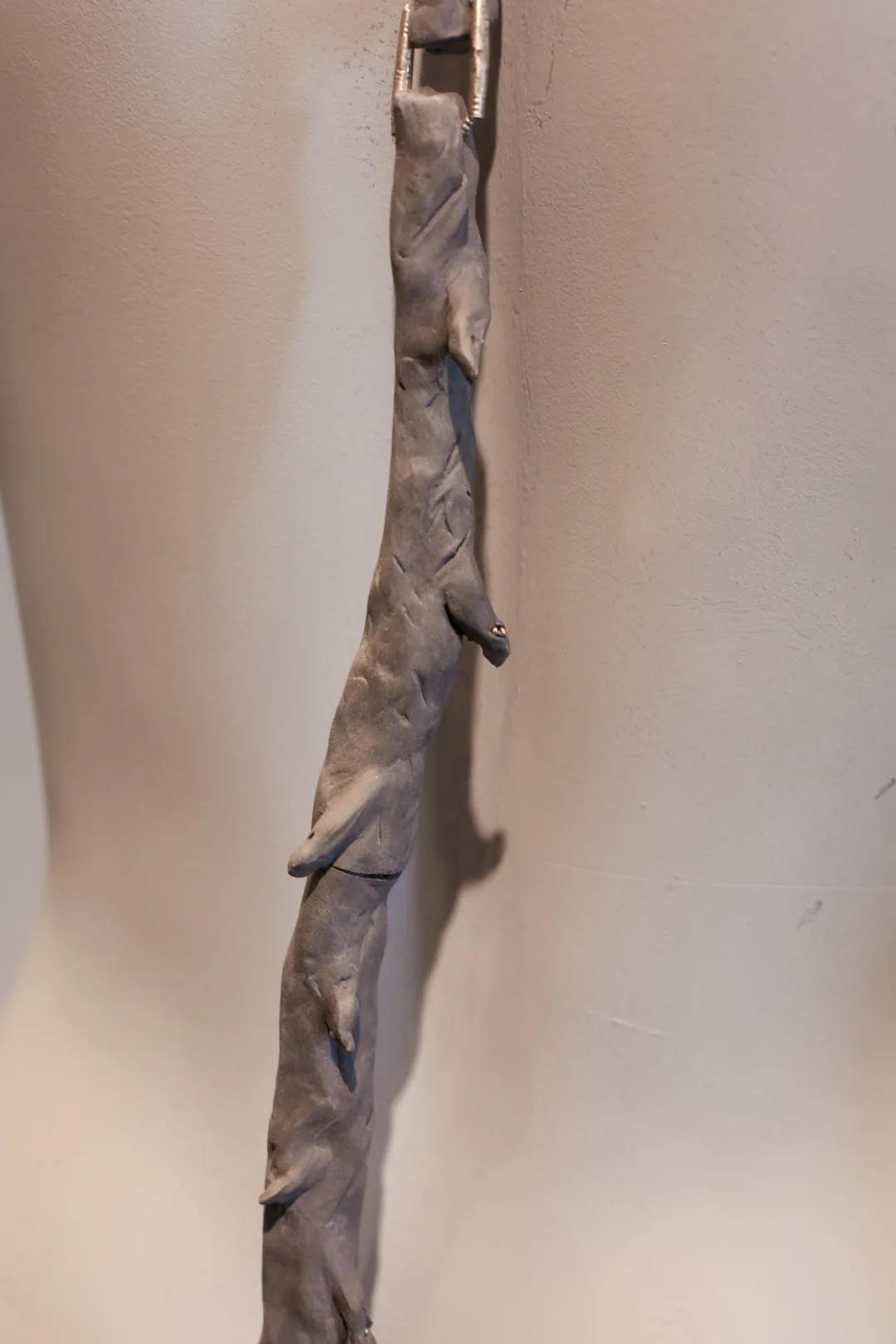
Details
细节图
Karin: I also wanted to make them (bones) in front. And also made golden ones. I painted them in gold before placing them in the kiln. So that it has very thin coverage of gold.
Karin: 我也想把骨头摆放在正面,并把其中两个骨头做成金色。在放入窑炉之前我在它们表面刷了一层金色涂料。所以在烧制之后便形成了一层很薄的金色涂层。
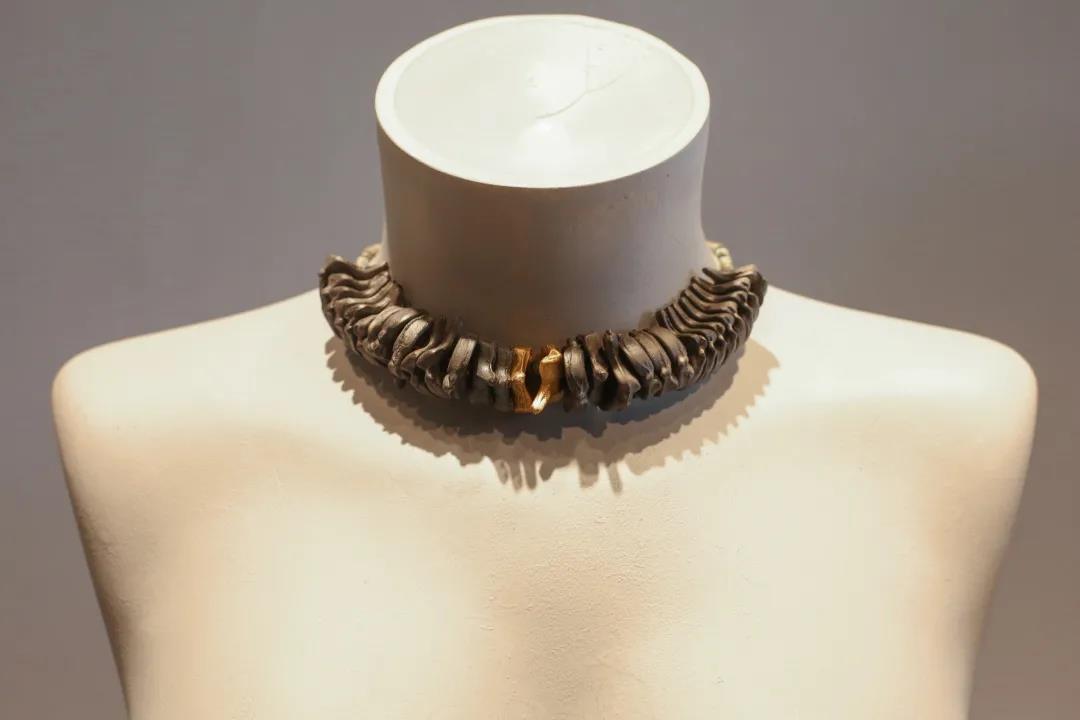
Photo by Yuxi Lu
Karin: This is also the leather from the Toeareg of Africa. It (The middle part) was kind of a feeling to hide the bones.
Karin: 这件作品的皮革也是来自非洲的图阿雷格人。(中间部分)有一种把骨头藏起来的感觉。
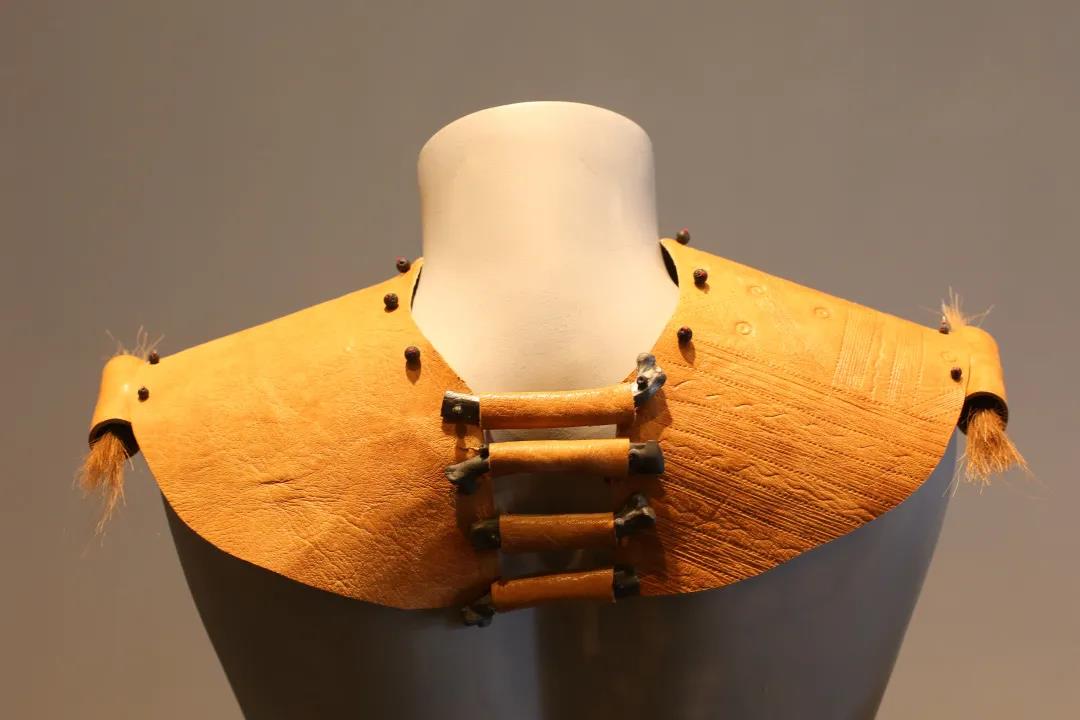
Photo by Yuxi Lu
Lu: I can also feel the contrast between the softness of leather and the hardness of bones.
Lu: 我也能感受到柔软的皮革和坚硬的骨头之间的反差。
Karin: These (both sides) are also horsehair which is also very soft.
Karin: (两端的)马毛也十分柔软。
Karin: This piece has nothing to do with this theme. But I just wanted to show it. There was a contest in Shanghai -- the 2nd edition Contemporary Art Jewelry Exhibition 2021 themed “Intimate Relationship” by VONMO studio. This one was selected by the exhibition. And the exhibition will be held in Shanghai during the September of 2021. They asked people to make a piece of jewelry that had to do with intimate relationships. I thought I want to make a jewel that has to do with my family - My brothers and my sister. We were 5. And my youngest brother passed away. I thought I make five parts. We call it Medaillon in French (a piece of metal shaped like a large coin, worn as jewellery on a chain around the neck. An expression of faith). It has to do with Christianity. I asked my brothers and my sisters for their jewellery and I push all beads in clay and put them together.
Karin: 这件作品与本次主题没有关系。但我只是很想展示它。上海有一个投稿征集-由VONMO studio举办的第二届当代首饰展,主题是“亲密关系”。我的这件作品成功入选,将于2021年九月在上海展出。主办方要求参加者制作一件与亲密关系有关的首饰。我想制作一件与我家人相关的首饰-我的兄弟姐妹,我们一共五个人。我最年轻的兄弟去世了。我想做五个部分。法语中我们称它为“Medaillon”(一种外形类似于大型钱币的金属,通常附在链子上作为首饰佩戴在脖子上, 作为一种信仰的表达)。它与基督教有关。我向我的兄弟姐妹们收集了他们自己的首饰,将它们压在泥土上,并摆放在一起。


Photo by Yuxi Lu
Karin: And this (clay circle hanging on the back in the right picture) symbolizes the hair of my brother. He had hair like the African people with all these small curls. We are connecting with him. Because I like this piece so much. I thought I want to show it at this exhibition also.
Karin: 而这个(位于背部卷曲的陶瓷圆环)象征着我已去世的兄弟的头发。他有着像非洲人一样细小的卷发。我们所有人和他紧紧相连。因为我太喜欢这件作品了,所以我想在这次展览中展示它。
Lu: It looks very harmonious with other pieces.
Lu: 这件作品与其他作品摆放在一起也十分和谐。
Karin: When I use the thread, I like to use a red one, because it has to do with China.
Karin: 当我使用线绳的时候,我喜欢用红色的,因为它和中国有关。

Photo by Yuxi Lu
Lu: The symbol of luck.
Lu: 象征着好运。
Karin: Yes.
Karin: 是的。
Karin: These are beads from Mali, west of Africa. These have to do with death. It's always death and life.
Karin: 这些珠子来自位于非洲西部的马利。它们与死亡有关。总是关于生与死。
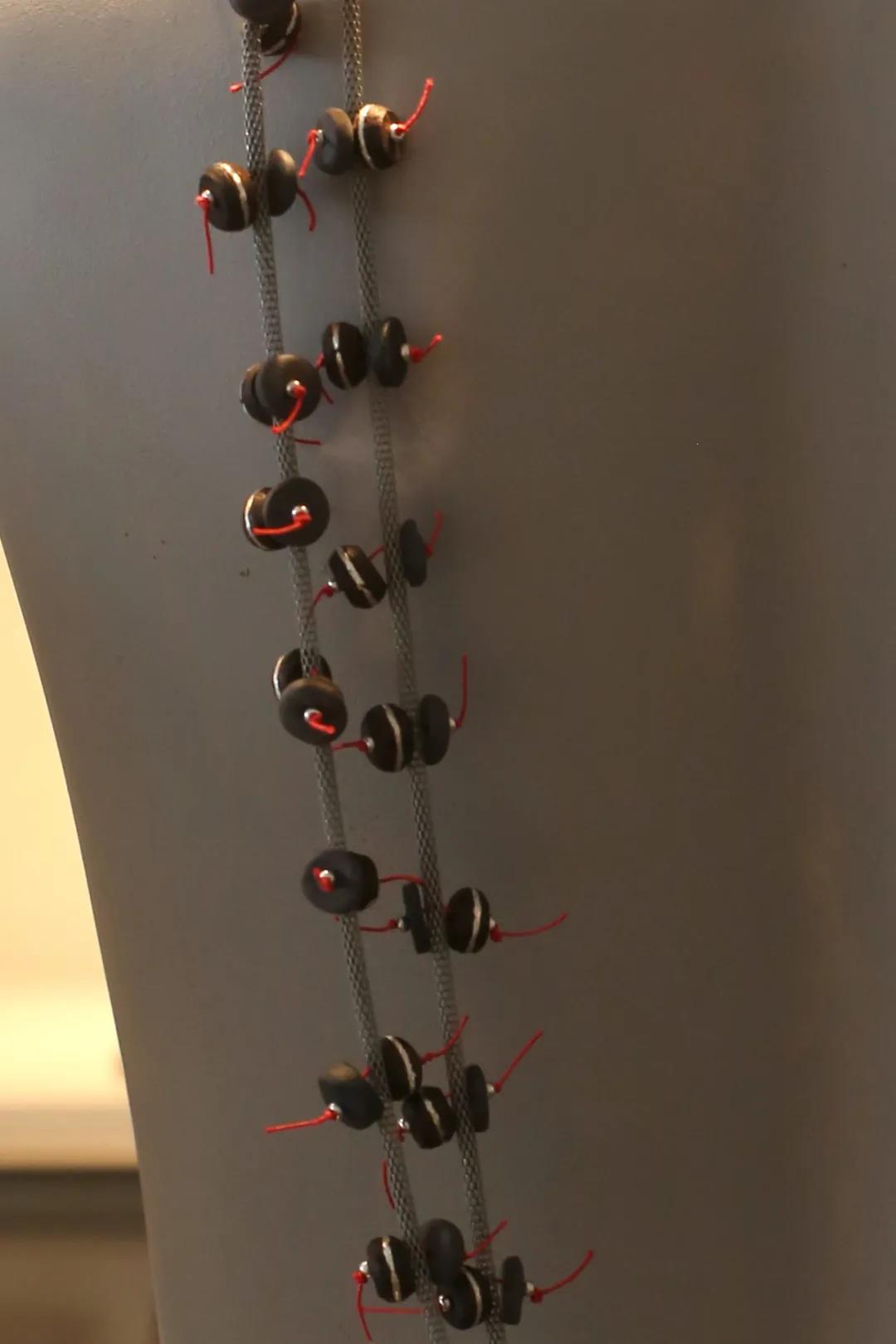
Details
细节图
Photo by Yuxi Lu
Karin: This is another idea of backbone. There is also a golden one. These beads are from western Africa.
Karin: 这是关于背脊的另一个想法。里面也有一块金色的。这些珠子来自非洲西部。

Photo by Yuxi Lu

Details
细节图
Lu: Are they also made of stone?
Lu: 他们也是由石头制作而成的吗?
Karin: No. It is iron beads made from bullets. The women who were in the war use bullets to make beads out of it.
Karin: 不是的,这些铁珠是子弹做成的。战争中的女人用子弹来制作的这些珠子。
Karin: This work shows a kind of optimistic attitude.
Karin: 这件作品展现了一种乐观的态度。

Photo by Yuxi Lu
Lu: growing up!
Lu: 向上生长!
Karin: Again, the leather of the African people in the front side. And you can see different colors of tails of the different horses.
Karin: 在正面我再次使用了来自非洲的皮革。并且你还能看见不同马尾巴所带有的不同毛色。

Photo by Yuxi Lu
Karin: This piece was chosen in an exhibition in the Dutch CODA Museum in the Keramiek Triënnale. They liked this one very much. Because it's open and closed at the same time. I connected two-half of the beads by putting hair through them.
Karin: 这件作品被荷兰CODA博物馆的一个陶瓷三年展选中。他们十分喜欢这件作品,因为它同时开合的状态。我把头发穿过两个半球将它们连接在了一起。
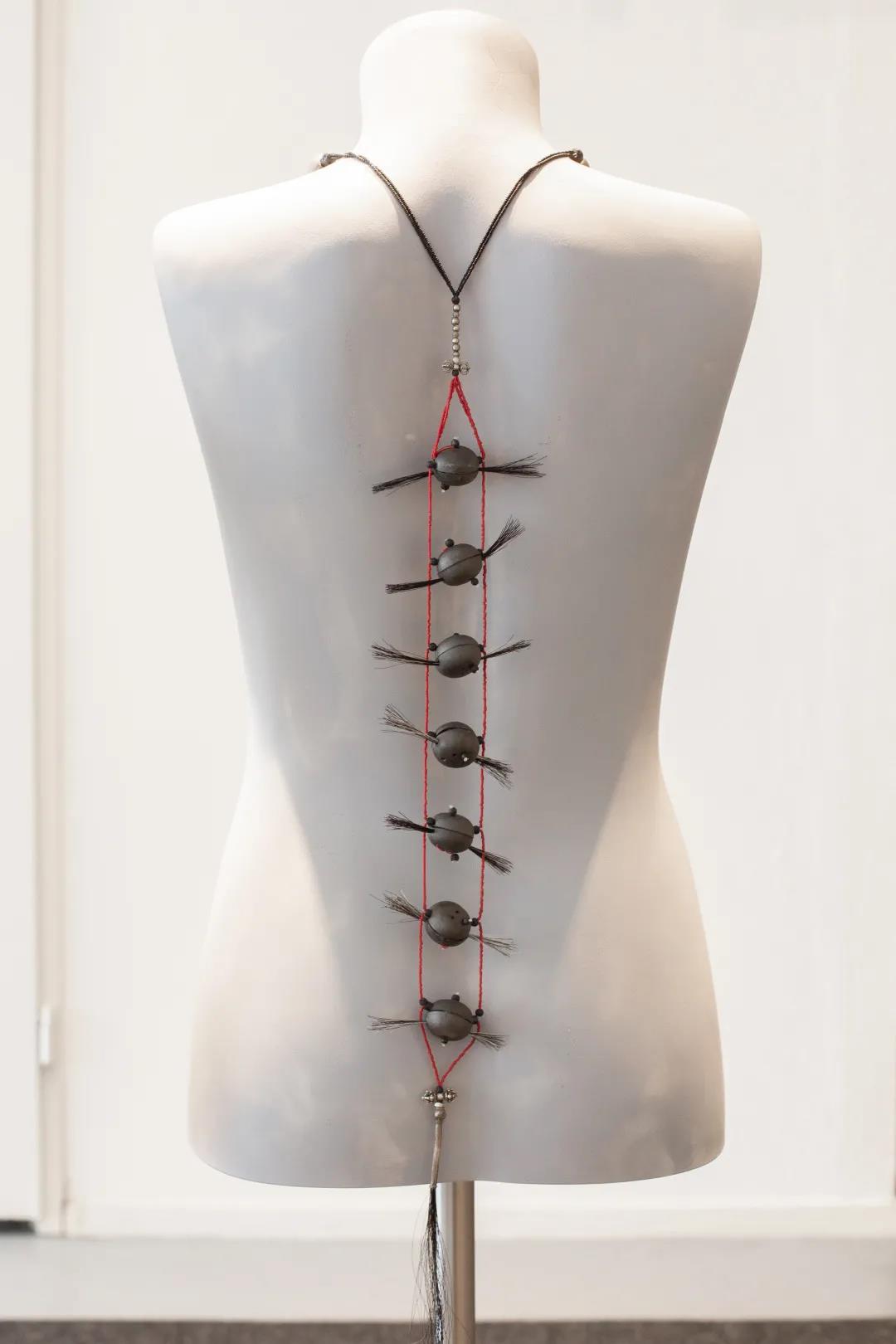
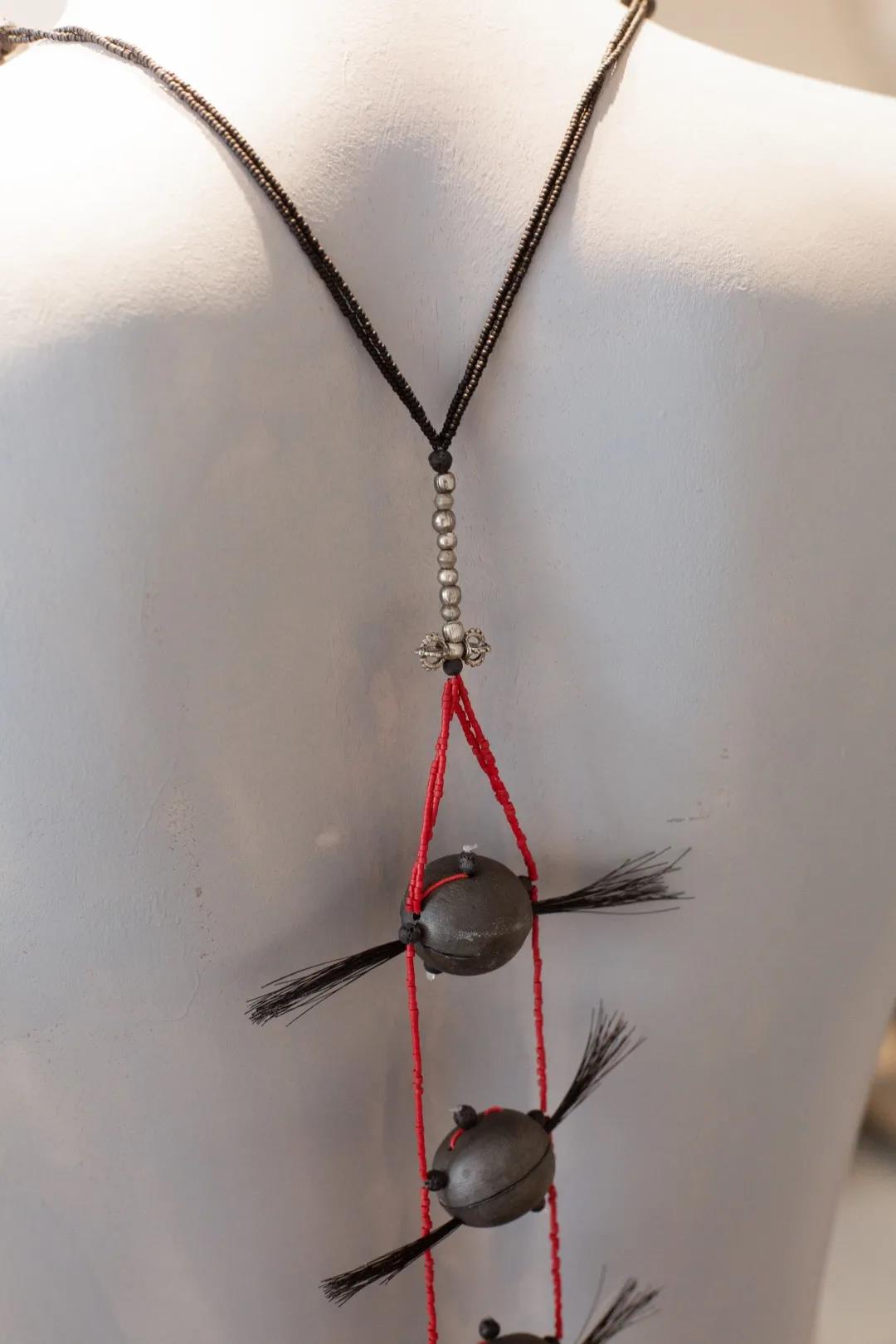
Details
细节图
Photo by Yuxi Lu
Karin: These beads are from western Africa.
Karin: 这些珠子是来自非洲西部。
Lu: Is it also made from the bullet?
Lu: 也是由子弹制作的吗?
Karin: No, it is not.
Karin: 不是的。
Karin: In the desert, the Toeareg have beautiful charms and beads. I pushed an amulet of the Toeareg into clay. And the negative of the shape shows up.
Karin: 在沙漠中的图阿雷格人有许多漂亮的护身符和珠子。我把一件图阿雷格人的护身符压在了泥土上,随后它的负形就浮现在了表面。

Photo by Yuxi Lu
Karin: This piece is made of pig bladder. I put all pieces together.
Karin: 这件作品是由猪皮制成,我将它们全部连在了一起。
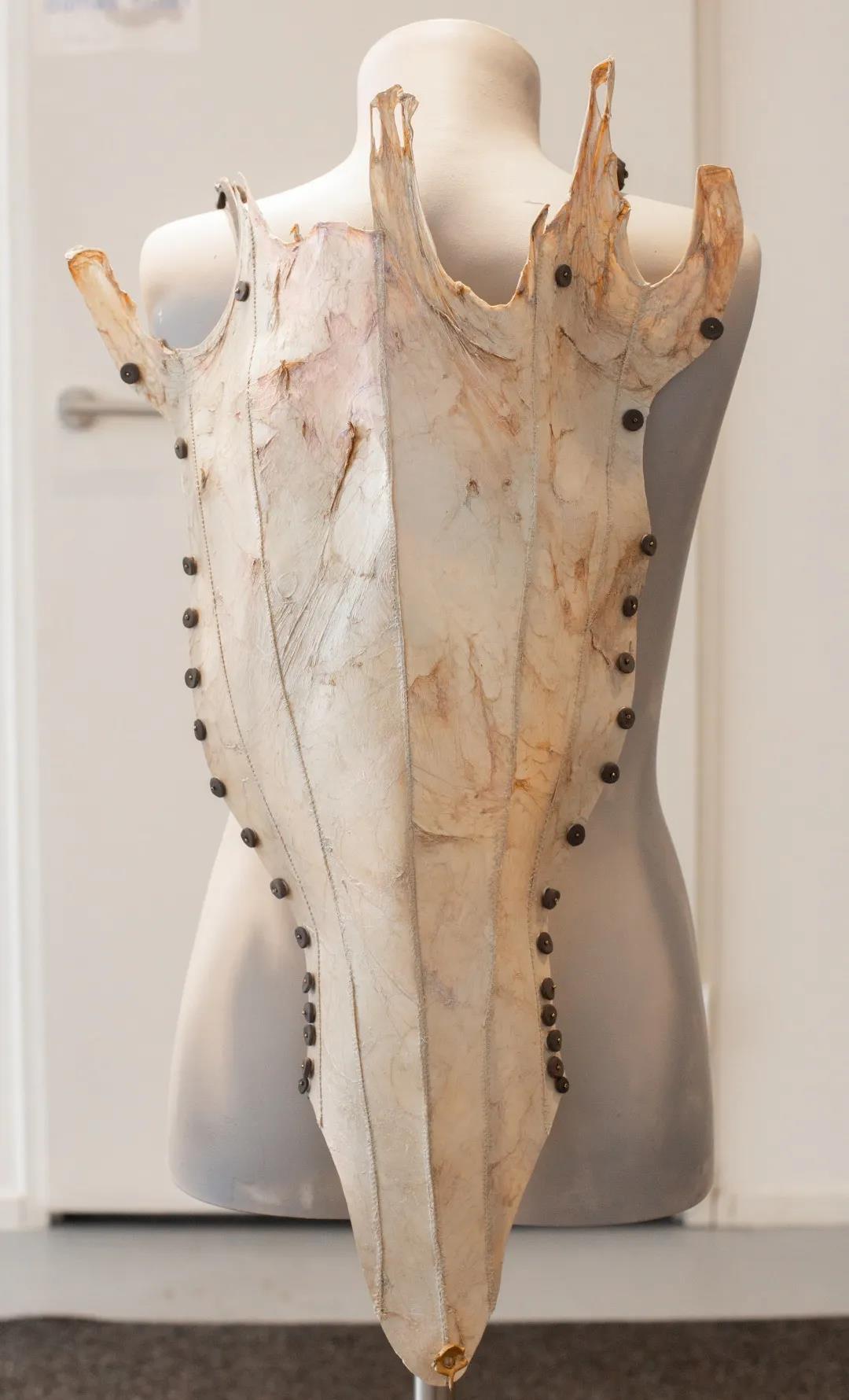
Photo by Yuxi Lu
Lu: You cut the pieces and then connected them?
Lu: 你将它们裁剪下来然后再连接的吗?
Karin: Yes.
Karin: 是的。
Karin: And I found it (The red object with Chinese traditional pattern in the middle) on a market of China.
Karin: 这个(位于中间有着中国传统图案的红色物件)是我在中国的市场上找到的。

Photo by Yuxi Lu
Lu: I like the different ways you hang the beads. And the way of representing your feelings of traditional Chinese culture by using the red color which is symbol of luck.
Lu: 我很喜欢你悬挂珠子的不同方式,以及通过运用象征幸运的红色来展现你对中国传统文化的感受。
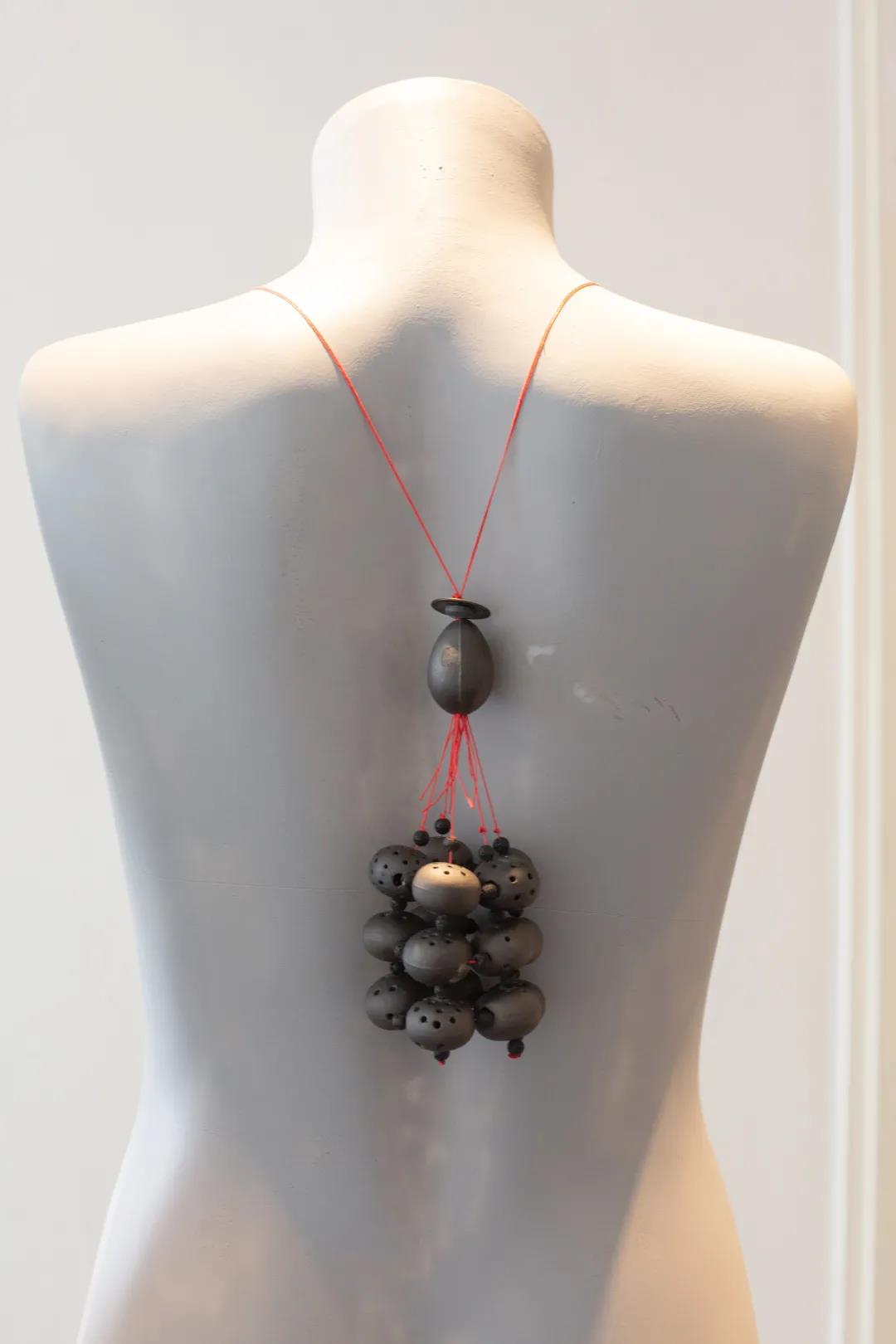
Photo by Yuxi Lu
Karin: I was making the horsehair in a repetition way. I love it. But at the same time, it is difficult to use horsehair, because it is thick and curled. Despite that, I still like to work with it.
Karin: 我不断重复地使用马毛。我很喜欢它。但同时使用马毛也是十分困难的,因为它很粗也很卷。尽管如此,我仍然喜欢在作品中使用它。

Photo by Yuxi Lu
Lu: This piece has a strong visual effect.
Lu: 这件作品有很强的视觉效果。
Karin: Yes. This one is in the front instead of back.
Karin: 是的,这件作品我把马毛放在了身体正面而不是后背。
Karin: Then this one was the last one I made. Because I started to make this in the last few months. I thought about doing something with it. I still had pain at that time. This one is quite heavy and rough, because they are not hollow.
Karin: 这件作品是我制作的最后一件。因为这是在最近几个月开始制作的,那个时候我仍然感到疼痛。所以我想要做点什么来表达我的感受。这一件十分沉重且粗旷,因为他们不是空心的。

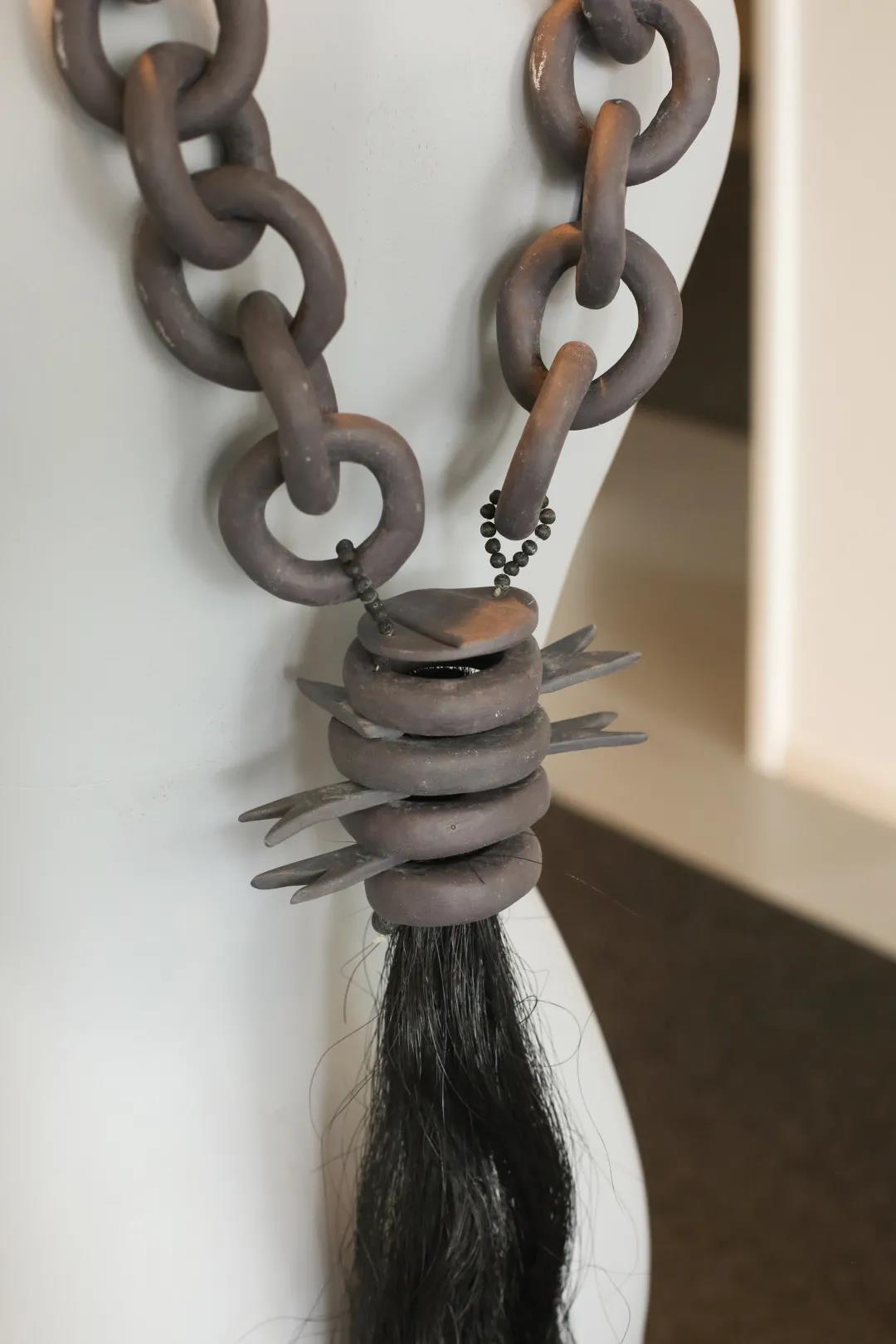
Details
细节图
Photo by Yuxi Lu
Contacts of artist and gallery
艺术家和画廊联系方式:
Karin van Paassen,
curator & designer
Rietdijkstraat 52
3151 GJ Hoek van Holland
the Netherlands
+31 (0)6 24373714
kvanpaassen@upcmail.nl
www.karinvanpaassen.com
www.karinvanpaassen.jewelry
Galerie Wind
Address: Prins Hendrikkade 124a
3071 KL Rotterdam
Tel: +31 (0)10 - 233 1335
Mobile: + 31 6 546 130 95
Web: info@galeriewind.nl
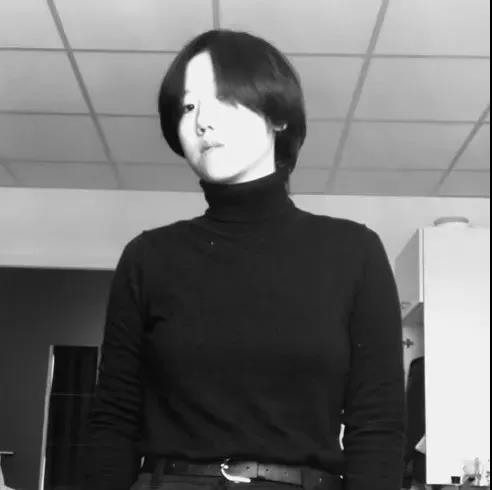
卢雨曦
特派员 / Correspondent
卢雨曦,出生于重庆。2019年毕业于四川美术学院首饰设计系,现就读于比利时安特卫普皇家艺术学院Jewellery Design & Gold and Silversmithing专业。对中西方文化差异以及跨学科创作,如图片摄影、影像制作、装置艺术有浓厚兴趣。
近期被这句话激励着:
“Every Cloud Has A Silver Lining”
“乌云背后总有一丝光芒”
期待交流与学习
Ins: yuxi__lu

 AIVA公众号
AIVA公众号 小红书:AIVA当代首饰
小红书:AIVA当代首饰 AIVA当代首饰
AIVA当代首饰 AIVA国际课程中心
AIVA国际课程中心 沪公网安备 31010602004641号
沪公网安备 31010602004641号